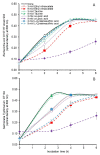Assessment of Potential Anti-Methanogenic and Antimicrobial Activity of Ethyl Nitroacetate, α-Lipoic Acid, Taurine and L-Cysteinesulfinic Acid In Vitro
- PMID: 38257860
- PMCID: PMC10819541
- DOI: 10.3390/microorganisms12010034
Assessment of Potential Anti-Methanogenic and Antimicrobial Activity of Ethyl Nitroacetate, α-Lipoic Acid, Taurine and L-Cysteinesulfinic Acid In Vitro
Abstract
Livestock producers need new technologies to maintain the optimal health and well-being of their animals while minimizing the risks of propagating and disseminating pathogenic and antimicrobial-resistant bacteria to humans or other animals. Where possible, these interventions should contribute to the efficiency and profitability of animal production to avoid passing costs on to consumers. In this study, we examined the potential of nitroethane, 3-nitro-1-propionate, ethyl nitroacetate, taurine and L-cysteinesulfinic acid to modulate rumen methane production, a digestive inefficiency that results in the loss of up to 12% of the host's dietary energy intake and a major contributor of methane as a greenhouse gas to the atmosphere. The potential for these compounds to inhibit the foodborne pathogens, Escherichia coli O157:H7 and Salmonella Typhimurium DT104, was also tested. The results from the present study revealed that anaerobically grown O157:H7 and DT104 treated with the methanogenic inhibitor, ethyl nitroacetate, at concentrations of 3 and 9 mM had decreased (p < 0.05) mean specific growth rates of O157:H7 (by 22 to 36%) and of DT104 (by 16 to 26%) when compared to controls (0.823 and 0.886 h-1, respectively). The growth rates of O157:H7 and DT104 were decreased (p < 0.05) from controls by 31 to 73% and by 41 to 78% by α-lipoic acid, which we also found to inhibit in vitro rumen methanogenesis up to 66% (p < 0.05). Ethyl nitroacetate was mainly bacteriostatic, whereas 9 mM α-lipoic acid decreased (p < 0.05) maximal optical densities (measured at 600 nm) of O157:H7 and DT104 by 25 and 42% compared to controls (0.448 and 0.451, respectively). In the present study, the other oxidized nitro and organosulfur compounds were neither antimicrobial nor anti-methanogenic.
Keywords: Escherichia coli; Salmonella; ethyl nitroacetate; rumen methane inhibitors; α-lipoic acid.
Conflict of interest statement
The authors declare no conflicts of interest.
Figures


References
-
- Anderson R.C., Jung Y.S., Oliver C.E., Horrocks S.M., Genovese K.J., Harvey R.B., Callaway T.R., Edrington T.S., Nisbet D.J. Effects of nitrate or nitro-supplementation, with or without added chlorate, on Salmonella enterica serovar Typhimurium and Escherichia coli in swine feces. J. Food Prot. 2007;70:308–315. doi: 10.4315/0362-028X-70.2.308. - DOI - PubMed
-
- Bozic A.K., Anderson R.C., Callaway T.R., Nisbet D.J., Ricke S.C., Crandall P.G., O’Bryan C.A. In vitro comparison of nitroethane, 2-nitro-1-propanol, lauric acid, LauricidinTM and the Hawaiian marine algae, Chaetoceros activity against anaerobically grown Staphylococcus aureus. Int. J. Appl. Res. Vet. Med. 2010;8:180–184.
-
- Bozic A.K., Anderson R.C., Ricke S.C., Crandall P.G., O’Bryan C.A. Comparison of nitroethane, 2-nitro-1-propanol, lauric acid, LauricidinTM and the Hawaiian marine algae, Chaetoceros, for potential broad-spectrum control of anaerobically grown lactic acid bacteria. J. Environ. Sci. Health Part B. 2012;47:269–272. doi: 10.1080/03601234.2012.638883. - DOI - PubMed
LinkOut - more resources
Full Text Sources
Molecular Biology Databases

